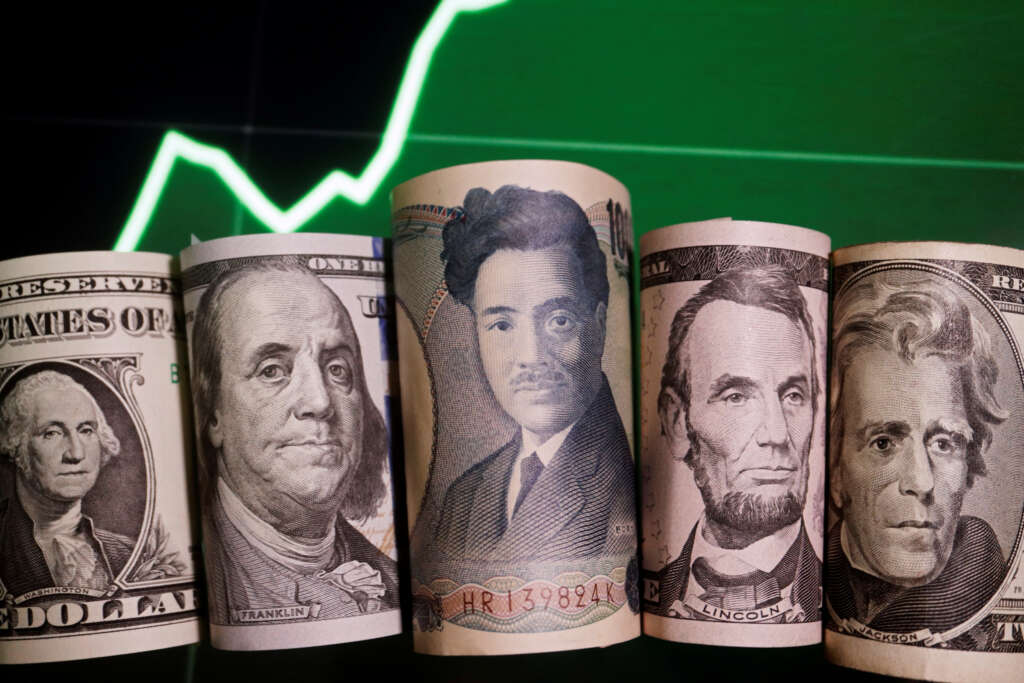
Dollar scales 10-month top as rate jitters persist
By Rae Wee
SINGAPORE (Reuters) – The dollar rose to a 10-month high against its major peers on Wednesday, toppling the euro and sterling to 6-month lows and pushing the yen deeper into intervention territory, as the prospect of higher-for-longer U.S. rates gripped markets.
U.S. Treasuries stabilised after a heavy selloff in recent days, though yields remained elevated and kept the greenback solidly bid. [US/]
The euro was last 0.14% lower at $1.05575, after slumping to a six-month low of $1.05555 earlier in the session. The single currency was on track to lose more than 3% for the quarter, its worst quarterly performance in a year.
Sterling was similarly down 0.09% at $1.2146 after hitting a six-month trough of $1.2141 earlier on Wednesday, and was headed for a quarterly loss of more than 4%.
The U.S. dollar index meanwhile peaked at a 10-month high of 106.30.
“The U.S. dollar is stickier to the upside than the downside,” said Tina Teng, market analyst at CMC Markets.
“It’s (been) a shock for markets since last week because the Federal Reserve’s rhetoric was more hawkish than expected … I think it’s more likely they would hike rates for one more time.”
Fed officials have in recent days flagged the possibility that the central bank would need to raise interest rates further, after it kept rates steady last week but stiffened its hawkish monetary policy stance.
That has sent U.S. Treasury yields scaling multi-year highs in recent days as money markets adjust their expectations of where U.S. rates could peak, and for monetary conditions to remain tighter for longer than initially thought.
The benchmark 10-year yield was last at 4.5255%, after hitting a 16-year high of 4.5660% in the previous session. The two-year yield stood at 5.0644%.
The elevated U.S. yields have spelt trouble for the yen, which edged marginally higher to 149.03 per dollar, after having slipped to a 11-month low of 149.185 on Tuesday.
The dollar/yen pair tends to be extremely sensitive to changes in long-term U.S. Treasury yields, particularly on the 10-year front.
The yen’s slow-but-steady decline to the psychological level of 150 per dollar has kept traders on high alert for any signs of intervention from Japanese authorities, as officials ramp up their rhetoric against the sliding currency.
The 150 zone is seen by some as a red line that would spur Japanese authorities to intervene, like they did last year.
“The fundamental upside pressure (to dollar/yen) from bond yields is simply too great to ignore,” said Alvin Tan, head of Asia FX strategy at RBC Capital Markets.
“Even if there were intervention, it won’t drive dollar/yen down permanently unless bond yields start to retreat in earnest too.”
Minutes of the Bank of Japan’s July meeting out on Wednesday showed that policymakers agreed on the need to maintain ultra-loose monetary settings but were divided on how soon the central bank could end negative interest rates.
Elsewhere, the Aussie fell 0.20% to $0.6385, barely blinking to Wednesday’s data pointing to an acceleration in Australia’s inflation last month, matching expectations.
“Today’s report does nothing to change the dial for the (Reserve Bank of Australia) in my view, who will likely hold rates at 4.1% at their next meeting,” said Matt Simpson, senior market analyst at City Index.
The New Zealand dollar slipped 0.23% to $0.5931.
(Reporting by Rae Wee; Editing by Shri Navaratnam)


